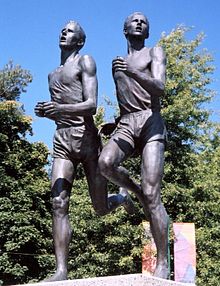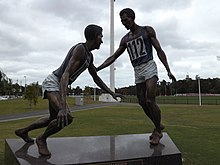John Landy
John Landy AC CVO MBE FTSE | |
|---|---|
 Landy in 1954 | |
| 26th Governor of Victoria | |
| In office 1 January 2001 – 7 April 2006 | |
| Monarch | Elizabeth II |
| Premier | Steve Bracks |
| Lieutenant | Lady Marigold Southey |
| Preceded by | Sir James Gobbo |
| Succeeded by | David de Kretser |
| Personal details | |
| Born | John Michael Landy 12 April 1930 Melbourne, Victoria, Australia |
| Nationality | Australian |
| Spouse(s) | Lynne Landy (née Fisher) |
| Alma mater | University of Melbourne |
| Occupation | Athlete, governor |
 Ron Delaney and John Landy (right) at the 1956 Olympics | |||||||||||||||||
| Personal information | |||||||||||||||||
|---|---|---|---|---|---|---|---|---|---|---|---|---|---|---|---|---|---|
| Height | 182 cm (6 ft 0 in) | ||||||||||||||||
| Weight | 69 kg (152 lb) | ||||||||||||||||
| Sport | |||||||||||||||||
| Sport | Athletics | ||||||||||||||||
| Event(s) | 1500 m – 3 miles | ||||||||||||||||
| Club | Geelong Guild Athletics Club, Belmont, Victoria | ||||||||||||||||
| Achievements and titles | |||||||||||||||||
| Personal best(s) | 1500 m – 3:41.8 (1954) 3 miles – 13:27.4 (1956)[1][2] | ||||||||||||||||
hide
Medal record
| |||||||||||||||||
John Michael Landy AC CVO MBE FTSE (born 12 April 1930) is an Australian retired middle-distance runner and state governor. He was the second man to break the four-minute mile barrier in the mile run and held the world records for the 1500-metre run and the mile race. He was also the 26th Governor of Victoria from 2001 to 2006.
Education[]
Born in Melbourne, Victoria, on 12 April 1930, Landy attended Malvern Memorial Grammar School and Geelong Grammar School. He graduated from the University of Melbourne in 1954, receiving a Bachelor of Agricultural Science.
Athletics[]
During his school years, Landy enjoyed watching middle-distance track events. He became a serious runner during his college years, joining the in 1949; he was a member of the Australian Olympic team at both the 1952 Summer Olympics in Helsinki and 1956 Summer Olympics in Melbourne, taking the Olympic Oath at the 1956 Olympics.[3] On 21 June 1954, at an international meet at Turku, Finland, Landy became the second man, after Roger Bannister, to achieve a sub-4-minute mile, recording a world record time of 3:57.9, ratified by the IAAF as 3:58.0 owing to the rounding rules then in effect. That record held for more than three years.
Landy ran his second sub-4-minute mile at the 1954 British Empire and Commonwealth Games, held at Vancouver, British Columbia, in the mile race, but lost to Roger Bannister, who had his best-ever time. This meeting of the world's two fastest milers was alternately called "The Miracle Mile", the "Race of the Century", and the "Dream Race"; it was heard over the radio [4] by 100 million people and seen on television by millions more. On the final turn of the last lap, as Landy looked over his left shoulder, Bannister passed him on the right. A larger-than-life bronze sculpture of the two men at this moment was created by Vancouver sculptor Jack Harman in 1967 from a photograph by Vancouver Sun photographer Charlie Warner and stood for many years at the entrance to Empire Stadium; after the stadium was demolished, the sculpture was moved to the Hastings and Renfrew entrance of the Pacific National Exhibition (PNE) fairgrounds. In 2015, it returned to the site of the stadium.[5] Regarding this sculpture, Landy quipped that "While Lot's wife was turned into a pillar of salt for looking back, I am probably the only one ever turned into bronze for looking back."[6]


At the 1956 Australian National Championships prior to the Melbourne Olympic Games, in the final of the mile race, Landy stopped and doubled back to check on fellow runner Ron Clarke after another runner clipped Clarke's heel, causing him to fall early in the third lap of the race. Clarke, the then-junior mile world record holder, who had been leading the race, got back to his feet and started running again; Landy followed. In the final two laps Landy made up the deficit to win the race. The National Centre for History and Education in Australia said that "[i]t was a spontaneous gesture of sportsmanship and it has never been forgotten."[7] Sculptor Mitch Mitchell created a bronze sculpture of the moment when Landy helps Clarke to his feet. It was moved from the north west corner of Punt Road and Swan Street to Olympic Park, Melbourne.
Governor of Victoria[]
On 1 January 2001, Landy was sworn in as the 26th Governor of Victoria, succeeding Sir James Gobbo. He was appointed by Premier of Victoria Steve Bracks, who remained premier throughout his term. On 15 March 2006, in the final month of his term as governor, Landy was the final runner in the Queen's Baton relay during the 2006 Commonwealth Games Opening Ceremony at the Melbourne Cricket Ground stadium in Melbourne, presenting the baton to the Queen by placing it in its specially constructed holder. Landy retired as governor on 7 April 2006, being succeeded by David de Kretser.
Other accomplishments[]
Landy worked as senior manager at ICI Australia, and had a public speaking career. For eight years (1971–78) Landy served on the , contributing to debates and recommendations about the balanced use of public land across Victoria.[8] Landy has written two books on natural history: Close to Nature (1984) and A Coastal Diary, Pan Macmillan Australia, 1993.
Landy was Commissioner-General for the Australian pavilion at Expo 86 Vancouver. On 12 February 2009 Landy was appointed the chair of the Victorian Bushfire Appeal Fund Advisory Panel.[9] He stood down from the position on 7 September that same year.
Honours and awards[]
In 1949 and 1950 Landy, played Australian rules football for Dookie College[10] when he was at the University of Melbourne's – Dookie College campus and won the 1950 Central Goulburn Valley Football League's best and fairest award.[11]
In 1955, Landy was made a Member of the Order of the British Empire (MBE) for services to sport,[12] was awarded the Australian Sports Medal in 2000,[13] and in 2001 was awarded the Centenary Medal,[14] made a Companion of the Order of Australia (AC),[15] and a Knight of Grace of the Most Venerable Order of the Hospital of St John of Jerusalem. In 2006 he was appointed a Commander of the Royal Victorian Order (CVO) during the Queen's visit to Australia.[16] Landy was inducted into the Sport Australia Hall of Fame in 1985.[17]
Over the years, Landy has been awarded honorary degrees, the first being a Doctor of Laws from the University of Victoria in 1994. Then, in 1997, a Doctor of Rural Science from the University of New England, followed by a Doctor of Laws from the University of Melbourne in 2003 and Doctor of Laws from Deakin University in 2009. Landy has been a Member of The Graduate Union of The University of Melbourne since 2005.
On 12 July 2008, Landy was the guest speaker at his club's Centenary Dinner held at North Geelong. Landy has been a Life Member of the since April 1958. Named after Landy, Landy Field in South Geelong is the Geelong region's major athletic facility. East Doncaster Secondary College has a VCE centre dedicated in Landy's honour. Central Park, in Malvern East, Melbourne has a sports oval dedicated to Landy with a plaque which reads in part "Named in honour of John Landy, resident of Central Park Road, who used this oval for his training..."
In media[]
In the 1988 television mini-series The Four Minute Mile, detailing the rivalry between Landy and Roger Bannister, Landy was portrayed by actor Nique Needles.
See also[]
References[]
- ^ John Landy. sports-reference.com
- ^ John Landy. trackfield.brinkster.net
- ^ IOC 1956 Summer Olympics. Olympic.org (6 September 2016). Retrieved on 20 September 2017.
- ^ Radio broadcast of the Miracle Mile. The broadcast from an actual radio transcription disc of the time.
- ^ The rebirth of Empire Fields. Vancouversun.com (17 July 2015). Retrieved on 20 September 2017.
- ^ CA.News.Yahoo.com Archived 26 December 2009 at the Wayback Machine
- ^ The Finest Sporting Gesture in the History of Sport? . Hyperhistory.org. Retrieved on 20 September 2017.
- ^ Danielle Clode (2006) As if for a thousand years: A history of Victoria's Land Conservation and Environment Conservation Councils, Victorian Environmental Assessment Council
- ^ TheAustralian.News.au, Bereavement fund for bushfire victims
- ^ "1954 - Landy played with Dookie College". Benalla Ensign. 24 June 1954. p. 10. Retrieved 24 July 2021.
- ^ "1950 - Central Goulburn FL - Best & Fairest Award". Shepparton Advertiser. 5 September 1954. p. 2. Retrieved 16 July 2020 – via Trove Newspapers.
- ^ It's an Honour – Member of the Order of the British Empire
- ^ It's an Honour – Australian Sports Medal
- ^ It's an Honour – Centenary Medal
- ^ It's an Honour – Companion of the Order of Australia
- ^ It's an Honour – Commander of the Royal Victorian Order
- ^ "John Landy". Sport Australia Hall ofFame. Retrieved 25 September 2020.
Further reading[]
| Wikimedia Commons has media related to John Landy. |
- FitzSimons, Peter (2006). Great Australian Sports Champions. Harper Collins Publishers. ISBN 0-7322-8517-8.
- The Perfect Mile: Three Athletes, One Goal, and Less Than Four Minutes to Achieve It, by Neal Bascomb, 2004, ISBN 0-618-39112-6
- 1930 births
- Living people
- Governors of Victoria (Australia)
- Australian Members of the Order of the British Empire
- Companions of the Order of Australia
- Australian Commanders of the Royal Victorian Order
- Australian male middle-distance runners
- Athletes from Melbourne
- Commonwealth Games silver medallists for Australia
- Commonwealth Games medallists in athletics
- Olympic athletes of Australia
- Athletes (track and field) at the 1952 Summer Olympics
- Athletes (track and field) at the 1956 Summer Olympics
- Athletes (track and field) at the 1954 British Empire and Commonwealth Games
- People educated at Geelong Grammar School
- People educated at Caulfield Grammar School
- Olympic bronze medalists for Australia
- University of Melbourne alumni
- Fellows of the Australian Academy of Technological Sciences and Engineering
- Sport Australia Hall of Fame inductees
- Medalists at the 1956 Summer Olympics
- Olympic bronze medalists in athletics (track and field)
- Oath takers at the Olympic Games
